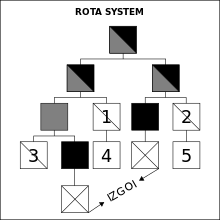Order of succession
Often, the line of succession is restricted to persons of the blood royal (but see morganatic marriage), that is, to those legally recognized as born into or descended from the reigning dynasty or a previous sovereign.Hereditary monarchies have used a variety of methods and algorithms to derive the order of succession among possible candidates related by blood or marriage.An advantage of employing such rules is that dynasts may, from early youth, receive grooming, education, protection, resources and retainers suitable for the future dignity and responsibilities associated with the crown of a particular nation or people.Such systems may also enhance political stability by establishing clear, public expectations about the sequence of rulers, potentially reducing competition and channeling cadets into other roles or endeavors.By contrast, older European monarchies tended to rely upon succession criteria that only called to the throne descendants of past monarchs according to fixed rules rooted in one or another pattern of laws or traditions.Other famous queens include Rudrama Devi, Keladi Chennamma, Ahilyabai Holkar, Velu Nachiyar and Gowri Lakshmi Bayi.Absolute primogeniture is a law in which the eldest child of the sovereign succeeds to the throne, regardless of gender, and females (and their descendants) enjoy the same right of succession as males.This is currently the system in Sweden (since 1980), the Netherlands (since 1983), Norway (since 1990), Belgium (since 1991), Denmark (since 2009),[2] Luxembourg (since 2011),[3] and in the United Kingdom and the Commonwealth realms (since 2013).The Salic law applied to the former royal or imperial houses of Albania, France, Italy, Romania, Yugoslavia, and Prussia/German Empire.In 1830 in Spain the question whether or not the Salic law applied – and therefore, whether Ferdinand VII should be followed by his daughter Isabella or by his brother Charles – led to a series of civil wars and the formation of a pretender rival dynasty which still exists.Former monarchies that operated under semi-Salic law included Austria (later Austria-Hungary), Bavaria, Hanover, Württemberg, Russia, Saxony, Tuscany, and the Kingdom of the Two Sicilies.If a female descendant should take the throne, she will not necessarily be the senior heiress by primogeniture, but usually the nearest relative to the last male monarch of the dynasty by proximity of blood.Usually after one king, his nephew through his sister succeeded to the throne, and his own son receives a courtesy title but has no place in the line of succession.This serves the circumstances where the youngest is "keeping the hearth", taking care of the parents and continuing at home, whereas elder children have had time to succeed "out in the world" and provide for themselves.Proximity of blood is a system wherein the person closest in degree of kinship to the sovereign succeeds, preferring males over females and elder over younger siblings.The most prominent examples of this practice are the multiple divisions of the Frankish Empire under the Merovingian and Carolingian dynasties, and similarly Gavelkind in the British Isles.[10] This was a special form of inheritance in which the second and younger son received more possessions and prestige than the apanage which was usual in principalities practising primogeniture.It avoided the generational division of the estate to the extent that occurred under gavelkind, and at the same time gave younger branches a stake in the stability of the house.In the rare cases in which the beneficiary was the third son in the order of succession, the second being already the holder of a secundogeniture, the domain given as a benefit was called a tertiogeniture.Historically the tanist was chosen from among the heads of the roydammna or "righdamhna" (literally, those of kingly material) or, alternatively, among all males of the sept, and elected by them in full assembly.Lateral or fraternal system of succession mandates principles of seniority among members of a dynasty or dynastic clan, with a purpose of election a best qualified candidate for the leadership.Where the line of succession is clear, it has sometimes happened that a pretender with a weak or spurious claim but military or political power usurps the throne.When an incumbent dies, his successor is sought in the general population by certain criteria considered to indicate that the reincarnated Dalai Lama has been found, a process which typically takes two to four years to find the infant boy.
- Grey: incumbent
- Square: male
- Circle: female
- Black: deceased
- Diagonal: cannot be displaced (see heir apparent )

- Grey: incumbent
- Square: male
- Circle: female
- Black: deceased
- Diagonal: cannot be displaced

- Grey: incumbent
- Square: male
- Black: deceased
- Diagonal: cannot be displaced

- Grey: incumbent
- Square: male
- Circle: female
- Black: deceased
- Diagonal: cannot be displaced

- Grey: incumbent
- Square: male
- Black: deceased

- Grey: incumbent
- Square: male
- Circle: female
- Black: deceased
- Diagonal: cannot be displaced

- Grey: incumbent
- Square: male
- Black: deceased
- Diagonal: cannot be displaced

- Grey: incumbent
- Half-grey: predecessor of incumbent
- Square: male
- Black: deceased
- Diagonal: cannot be displaced
- cross: excluded or Izgoi (excluded from succession due to their parent never having held the throne)
head of statetitle of nobilityHereditary governmentelected governmentelectionpresidencyPresident of IndiaVice-President of IndiaelectedPresident of the PhilippinesVice-President of the PhilippinesOrganizationssuccession planningpower vacuumsinheritanceheirs of the bodyprimogeniturepropertygranteekinshippeeragemonarchylegitimateadoptiveheirs portionerspartible inheritancehereditary monarchiesmonarchblood royalmorganatic marriagereigningdynastyhouse lawscoronationHenry the Young Kingelective monarchiesKing of the RomansHabsburgtanistrycadetsImperial FranceNapoleon IKingdom of ItalysecundogenitureEugène de Beauharnaisblood relationshipHouse of BonapartePrince Alexander IHouse of KarađorđevićCarol I of RomaniaLeopold, Prince of Hohenzollernheir apparentList of female monarchsMonacoEnglandScotlandKingdom of Great BritainUnited KingdomCommonwealth realmsproximity of bloodPictishhereditary titlesabeyancejure uxorisjure matrisMarjorie, Countess of CarrickRobert the BruceIndian independence movementShahu IRajaram IIShahu IIGowri Lakshmi BayiTravancoreQueen Didda of KashmirQudsia BegumNawab of BhopalRudrama DeviKeladi ChennammaAhilyabai HolkarVelu NachiyarRazia SultanaDelhi SultanateSwedenNetherlandssince 1983Norwaysince 1990Belgiumsince 1991Denmarksince 2009Luxembourgsince 2013Salic lawAlbaniaFranceRomaniaYugoslaviaPrussiaGerman EmpireLiechtensteinChrysanthemum ThroneFerdinand VIIIsabellaCharlescivil warsagnatic senioritymale linepatrilineageAustria-HungaryBavariaHanoverWürttembergRussiaSaxonyTuscanyKingdom of the Two SiciliesChristian I of DenmarkMaria Theresa of AustriaWar of the Austrian SuccessionMarie-AdelaideCharlotte of LuxembourgAnne of BrittanyChristian IX of DenmarkLouise of HesseMatrilineal succession